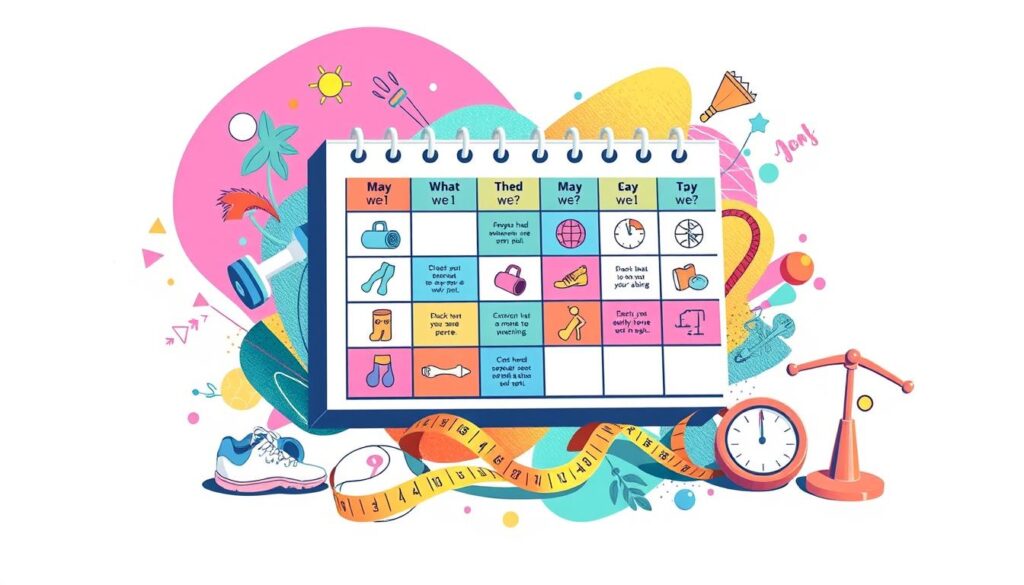Are you ready for a big change? This 4-week weight loss program will help you lose weight, feel more energetic, and be more confident. You’ll learn about good food, exercise, and healthy habits.
Exercise and healthy eating are key to losing weight. This 4-week plan will get you started. It focuses on burning more calories than you eat. You’ll do short, intense workouts that mix cardio and strength training.
Key Takeaways
- Achieve significant weight loss in just 4 weeks through a holistic approach
- Combine strategic nutrition, targeted exercise, and sustainable lifestyle changes
- Boost metabolism and burn more calories through a mix of cardio and strength training
- Experience increased energy, confidence, and overall well-being
- Develop healthy habits that can be maintained for long-term success
Understanding Body Transformation Fundamentals
Starting a body transformation is more than losing weight. It’s about changing your body’s fat to muscle ratio. Muscle is denser than fat, so your weight might not change or could even go up.
The Science Behind Weight Loss
Weight loss comes from burning more calories than you eat. This makes your body use fat for energy. But, eating too few calories can harm your muscle.
Calorie Deficit Explained
To lose 1 kilogram (2.2 pounds) a week, you need to burn over 1,000 calories daily. In 4 weeks, you can lose 4-6 kilograms (8-13 pounds) with hard work and a low-calorie diet.
Metabolic Rate Basics
Your metabolic rate is how many calories you burn at rest. It’s affected by age, gender, muscle, and genetics. Knowing your metabolism helps you plan better for weight loss.
“Successful client transformations at Fortius Dubai include Basil, Tom, Mark, and James who achieved significant progress in just 4 weeks through customized workout routines and diet plans.”
To see how you’re doing, track your body measurements and take photos weekly. A good workout and diet plan can help you lose fat and tone up in 4 weeks.
Creating Your Weight Loss 4 Weeks Program
To lose weight in 4 weeks, you need a good exercise routine and workout plan. Try to exercise 4-5 times a week. Mix cardio and strength training exercises.
High-Intensity Interval Training (HIIT) is great for quick, intense workouts. These can last 20-30 minutes. They mix intense exercise with rest or low-intensity exercise. This keeps your heart rate up and burns calories long after.
Do compound exercises like squats, deadlifts, and bench press. These work many muscles at once. They help build lean muscle and increase your metabolism. Add isolation exercises like bicep curls to target specific muscles.
Use progressive overload to keep challenging your muscles. Increase the weight, reps, or resistance in your fitness schedule. This keeps your weight loss program working and your body changing.
“A consistent, well-rounded workout plan is the foundation for a successful 4-week body transformation.”
With this approach, you’ll reach your weight loss goals in 4 weeks. You’ll see big changes in your body.
Nutrition Strategy for Rapid Results
Starting your weight loss journey is all about a good nutrition plan. Focus on eating whole, unprocessed foods. This means lots of vegetables, fruits, nuts, seeds, lean protein, and whole grains. Eating fewer calories than your body needs helps you lose weight fast.
Meal Planning Essentials
Good meal planning is crucial. Eat three balanced meals and two healthy snacks daily. This keeps hunger in check and helps you stay in a calorie deficit. Make sure each meal has protein, complex carbs, and healthy fats to keep you full and energetic.
Portion Control Guidelines
- Use smaller plates to naturally reduce portion sizes.
- Stick to recommended serving sizes for each food group.
- Measure out portions of high-calorie items like nuts, oils, and dressings.
- Avoid eating directly from packages or containers to prevent mindless overeating.
Optimal Macro Distribution
For quick weight loss, the right mix of macronutrients is key. Aim for a diet with higher protein, moderate carbs, and lower fats. This balance helps keep muscle while losing fat. Talk to a nutritionist or use an online calculator to find your best macro targets.
“The key to sustainable weight loss is making gradual, manageable changes to your diet and lifestyle.”
Exercise Routine Structure
Making a good workout plan is key to getting fit. Your routine should mix cardio and strength training. Use HIIT and sprints for quick cardio workouts.
For strength training, focus on big exercises that work many muscles. Also, do smaller exercises to target specific muscles. Always try to lift more weight to keep challenging your muscles.
- Beginners should do 2-3 cardio days and 2 strength days a week.
- Start with a moderate intensity, like a 5 out of 10.
- More experienced people should do 20-60 minutes of cardio, 5 times a week.
- Try interval training once or twice a week for extra benefits.
Rest and recovery are important to avoid injury and burnout. Try different workout plans to find what works best for you.

“The best workout program is the one you’ll actually do. Consistency is key, so find an exercise routine that you enjoy and can stick to long-term.”
Being flexible is the secret to a good workout plan. Change your routine as needed to meet your goals and needs. Getting fit is a personal journey, not a one-size-fits-all plan.
Strength Training for Fat Loss
Strength training is a great way to lose weight. It helps you build muscle, which makes you burn more calories. Do exercises for your upper, lower body, and core to lose fat.
Upper Body Workouts
Do exercises like bench press, shoulder press, and pull-ups. They work many muscles at once. Add bicep curls and tricep extensions to target specific muscles. Keep adding more weight or reps to get stronger.
Lower Body Training
Squats, deadlifts, and lunges are good for your lower body. They build strength and burn fat. These exercises work your glutes, quads, and hamstrings. Keep adding more weight or reps to keep challenging yourself.
Core Strengthening Exercises
A strong core helps with balance and stability. Do exercises like planks, leg raises, and ab crunches. They tone your midsection and help prevent injuries.
Remember, to lose fat with strength training, keep getting stronger. Increase the weight, reps, or sets over time. Eat well and do cardio too for the best results.
“Strength training is not just about building muscle; it’s about transforming your body, increasing your metabolism, and becoming a fat-burning machine.”
Cardio Programming for Maximum Impact
To lose weight, adding cardio to your routine is key. Cardio workouts burn fat and boost health. With the right plan, you can see big changes in four weeks.
Experts say to work out for 60 to 90 minutes, several times a week. The American College of Sports Medicine suggests 30 minutes of moderate exercise daily. Mixing up your workouts keeps things interesting and prevents getting bored.
High-Intensity Interval Training (HIIT) is great for burning fat and building muscle. It involves short, intense efforts followed by rest. HIIT boosts your heart health and fitness, making it perfect for losing weight.
Also, try fun cardio like swimming, biking, or rowing. Pick activities you like, so you’ll stick with them.
Cardio and strength training together are best for losing weight. This combo will change your body in just four weeks.
| Workout Type | Intensity Level | Heart Rate Range | Perceived Exertion |
|---|---|---|---|
| Low-Intensity | 60%-70% | 120-140 bpm | 4-5 |
| Moderate-Intensity | 70%-80% | 140-160 bpm | 5-7 |
| High-Intensity | 80%-90% | 160-180 bpm | 8-9 |

Try different cardio workouts at various levels to keep your routine exciting. Start slow if you’re new, and get tougher as you get fitter. This will help you reach your weight loss goals.
Tracking Progress and Measurements
Starting your weight loss journey? It’s key to track your progress well. Watch your body measurements, body composition, and progress photos. These help you see how far you’ve come and keep you motivated towards your fitness goals.
Body Composition Analysis
Don’t just look at the scale. It doesn’t show fat or muscle. Instead, check your body measurements and body fat percentage. Take chest, waist, hips, and thigh measurements every 2-4 weeks. Use a digital body fat scale to track your body composition.
Weekly Progress Photos
- Take full-body photos weekly, wearing the same clothes each time.
- Photos show changes in your body that the scale might miss.
- Seeing your progress tracking in photos can really motivate you.
Measurement Guidelines
Follow these tips for accurate measurements:
- Always use the same tape measure and spots.
- Measure at the same time each day, like morning before eating or working out.
- Wear little to no clothes and measure on bare skin for best results.
- Breathe normally and don’t hold your breath while measuring.
By tracking your body measurements, progress tracking, and weight loss monitoring carefully, you can celebrate your wins. You’ll also know when to tweak your fitness goals.
Recovery and Rest Protocols
Getting your body in shape is more than just eating right and working out. You also need enough rest and recovery. These help your body heal and get stronger.
Try to sleep for 7-8 hours every night. This helps your body fix itself and build muscles. Also, do things like yoga or meditation to relax and keep stress down.
Make sure to take rest days. This lets your muscles heal and grow. Studies show that taking breaks can be as good as always working out.
If you’ve been working out a lot, you might need a break. Look for signs like muscle soreness that lasts too long or feeling unmotivated. Use this time to do easy activities like walking or swimming.
Remember, muscle recovery, rest days, and sleep optimization are key to changing your body. They help you stay healthy and enjoy the journey.
“Adequate rest and recovery are crucial for body transformation. Ensure 7-8 hours of sleep per night for proper hormone regulation.”
Lifestyle Adjustments for Success
Starting a health journey is more than just eating right and working out. Changing your lifestyle can really help you succeed. Focus on sleep, stress, and daily habits to support your weight loss and health.
Sleep Optimization
Good sleep is key for hormone balance and weight control. Try to sleep 7-8 hours each night. This lets your body rest and get ready for the next day.
Make a bedtime routine, avoid screens before sleep, and keep your room quiet. This helps you sleep better and longer.
Stress Management
Too much stress can hurt your weight loss by messing with hormones. Find ways to relax every day, like meditation or hobbies. This keeps your mind calm and stops bad eating habits.
Daily Habit Formation
- Prioritize a consistent sleep schedule
- Engage in regular physical activity, even if it’s just a brisk daily walk
- Meal prep or plan your meals in advance to ensure nutritious choices
- Drink plenty of water throughout the day to stay hydrated
- Practice mindful eating by savoring your meals and listening to your body’s hunger and fullness cues
Building healthy habits is key to a lasting lifestyle change. Start small and keep it up. You’ll see big changes over time.
Living a healthy lifestyle and managing stress reduction are important. Also, focus on sleep quality and habit formation. These changes will help you reach your weight loss goals.
Conclusion
Congratulations on starting your body transformation journey! This 4-week weight loss program will help you see big changes.
Success in weight loss comes from working hard in your workouts and diet. Mix cardio and strength training to burn fat and keep muscle. Eat whole foods and eat fewer calories to lose weight.
Remember, losing weight takes time and effort. But with the right plan, you can see big changes in 4 weeks. Take progress photos and track your measurements to stay motivated. Don’t forget, your hormones, sleep, and stress levels also matter.
Enjoy this journey, celebrate your small victories, and trust the process. By living a healthy lifestyle, you’ll reach your weight loss goals and feel more confident. Good luck on your fitness journey!

